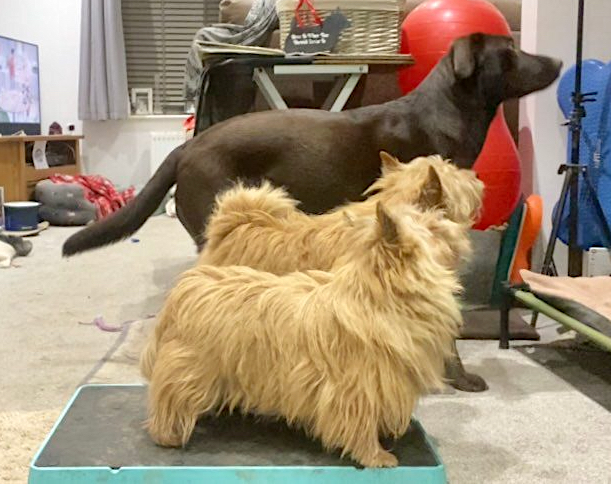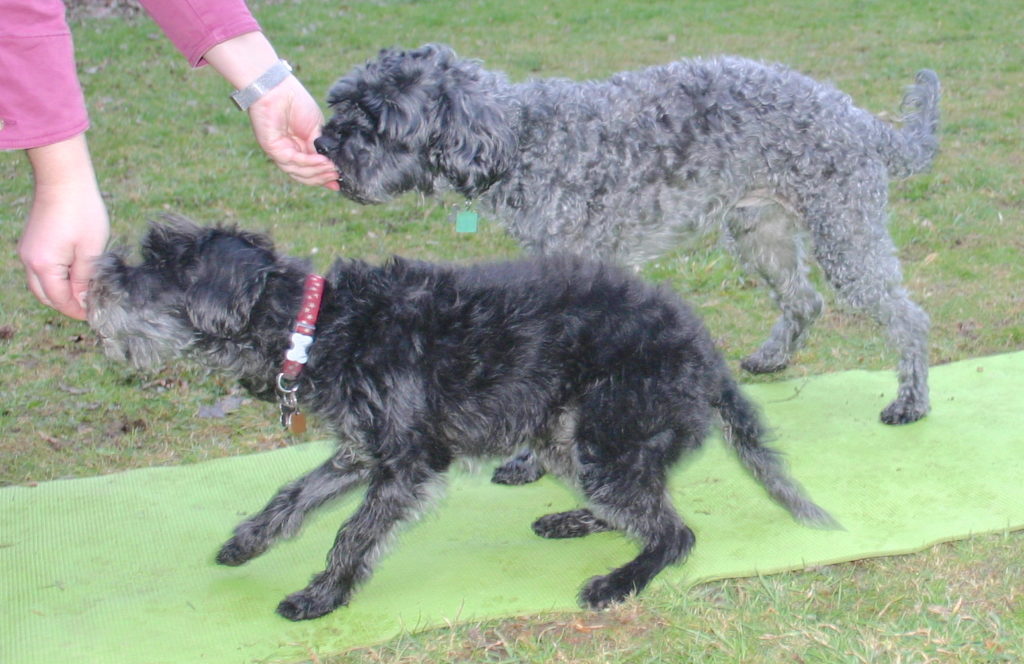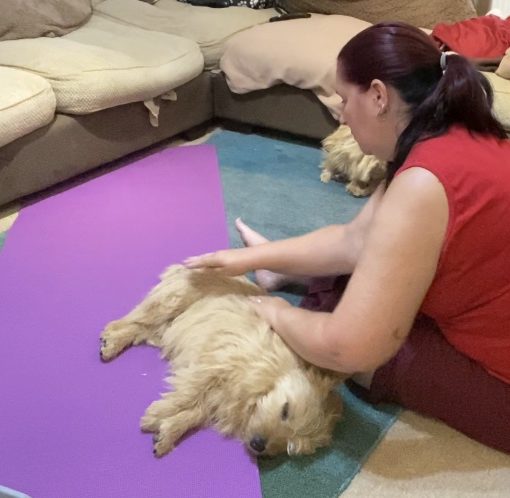
Written by Joe Nutkins, Kennel Club Accredited Dog Trainer, Certified Professional Canine Fitness Trainer, CAMadvocate (Canine Arthritis Management) Level 1:
Originally written for my original WordPress Blog JoeNutkinsDogTrainer 12/2/2021
Canine Arthritis is something most pet dog owners have heard of at some point of their dog owning time, but many haven’t actually witnessed this disease in a dog – or have they?
Arthritis in dogs, as with humans, is seen as a disease that affects only older ages and isn’t something to worry about until there’s a visible change such as struggling to get up after a nap or slowing down on walks. While these can be signs of arthritis in dogs they can actually be signs that OsteoArthritis is now advancing rather then just starting and can start when dogs are much younger then we generally realise.
Today’s blog I’ve written to hopefully highlight some areas of Canine Arthritis that are not commonly known to try and help pet dog owners identify the signs of possible Canine Arthritis, as well as how to help prevent the onset of Arthritis related issues and what they can do now if they suspect their dog may have some Arthritis taking place. It’s not intended to replace any Veterinary care, nor to cause worry or fear in owners about their dogs. We care about the dog’s we work with, live with and see when out and about and if we can help a couple not have discomfort that may not have been obvious then that is worth all the training, retraining, writing etc!!

What is the common age for Dogs to get Arthritis?
So, what sort of ages of dogs does Osteoarthritis affect in dogs? Dogs over 10? Dogs over 7? In reality it’s dogs of any age – including dogs under 12 months old. It’s a disease that affects the joints, as well as joint fluid, cartilage and many more areas of the dogs’ body and therefore isn’t recognised just by dog’s taking a little longer to get up from laying down or finding stairs a little tougher but has a huge number of signs linked to Arthritis!
Over 35% of ALL dogs over 12 months old have Arthritis. Not 35% of dogs over 7, that is 35% of dogs of ALL ages over 12 months old have arthritis – that’s a lot of dogs (1.2 million at least!)! More dogs will have arthritis at any age then we typically realise, because dogs are so good at adjusting to pain and discomfort and hiding the signs. When we notice a change in our dogs that are 7 years old, 4 years old, 12 months, 6 months… we consider maybe they slept funny, or slipped, or banged themselves while playing. We tend to not come to the Arthritis idea as it’s not something associated with younger dogs, but by understanding OA more and having more ideas on symptoms we can potentially arrange for treatments and therapies to prevent it worsening fast and to reduce the chance of pain for longer.
Canine Arthritis is one of the leading causes of early euthanasia due to dogs needing relief from all the pain – this is something we can help reduce!!
So what might we be looking for with our dogs that could indicate something has changed and they may need additional support from the vet and therapies? Here are some symptoms and some may surprise you but in my Canine Conditioning sessions I do see this a fair amount; compromised joints even in normal unstressed activities are more likely to be affected by some form of joint pain then ‘normal’ joints in normal unstressed activities. Likewise normal joints that receive stress from unusual movements and repetition can be as easily affected as compromised joints.
Symptoms and Signs of potential issues:
– Posture Change – your dog is standing with their head low, a dip or roach in the back, rear legs now under the body instead of slightly angled, elbows are positioned different. These are when you notice your dog didn’t used to stand in this way – not every dog with a lowered head has arthritis!
– Changes in behaviour such as suddenly worried about a noise they have always been fine with, not wanting to be touched somewhere that they have always liked having stroked such as the back end / spine / shoulders.
– Unable to hold a position correctly – if your dog has always had a nice tight square sit then starts looking a little ‘sloppy’ with a casual leg or knees flopping to the sides this can be an indication of discomfort.
– Fur changes can highlight a lot from bruising under the skin to joint issues. If your dog has a patch of fur suddenly wavy instead of straight, sticking up or flowing the wrong way then this can be a sign that the area under the fur has pain or discomfort.
– Taking longer to sit or lay down or refusing to when asked. You may have a dog that has done obedience for years and will sit at heel by the kerb, lay down on cue when visiting someone etc but if you notice that when you ask for a sit they don’t respond initially, or they go to sit and can’t seem to get comfy or when laying down they change the way they do it then this can be a big tell that something isn’t quite right.
– Changes in their favourite activities such as bumping into something they can usually step or jump over, walk through, dip under etc can show that they can’t move the body quite as well as previously or that signals are struggling to find their way to the paws and other areas where propreception is usually reliable. Likewise stopping jumping in the car or getting on the sofa can also be signs.
– Other symptoms that may not appear as symptoms can include panting, gastronomical issues, stomach pain and even skin issues! If in doubt check with your vet!
Did you know that dogs with diagnosed joint conditions can be more likely to develop arthritis in the same affected joints as well as other joints where the dog has tried to shift weight for comfort. Dogs who have had surgery to help a joint issue also have a higher chance of developing arthritis due to the weakend structure that joint. This is why keeping the body strong is crucial before and after surgery to help keep arthritis at bay for longer.

How can I help my Dog?
There are ways to help prevent the onset of Canine Arthritis, by helping your dog to protect their body and joints in their day to day activities as well as they more active interests!
– Does your dog jump off the sofa or bed when you leave the room or the doorbell goes or you ask if they want to go toilet? It’s just a single jump, impact to the front end including shoulders, cervical spine, elbows, wrists and toes but the occasional time won’t affect much, right? Consider how many times in a day your dog does this. In fact, when your next at home with your dog monitor and make a note of how many times!! If it’s 5 times in a whole day, that ‘s 35 times a week, 140 times a months! If it’s more then that’s a lot of impact on the body happening – remember an unnatural action on healthy joints will add up and on compromised joints will be causing issues that cannot yet be seen.
– In a smilier fashion, does jumping out of the car will be experiencing the same. They might only go out in the car once a week to go to training, so that’s jump out once for class and once when back at home. Still 8 times a months and from the boot can be quite a hight onto the concrete ground or gravel car park where paws can slip a little. If you have seen me take my Terriers out of my van you’ll seen me awkwardly put Merlin under one arm and lower to the ground then pick Ripley up with two hands and lower to the floor; I find it difficult with my own limitations from having ME but I don’t want them jumping out!!
– What are the floors like in the areas at home that your dog uses? Are any surfaces allowing even a tiny bit of slipping to happen as they walk, run, turn, play? Slippery floors are so commonly part of dog’s lives but can contribute to so many issues!! Consider this – a young puppy has their bed on a laminate flooring. Every morning they wake up and step out and just need to tense a little and compensate for their paws naturally wanting to slip. The same happens after a nap later in the afternoon and then in the evening. It happens as the puppy follows their family into the same room to do something and again while chasing a toy that has been rolled for them. How many times in that one day has that puppy slipped or worked hard to not slip? Potentially 3 + more likely over 10. So in a week that could be 21 to over 100 times. As a puppy, when they don’t have strong muscles, good body awareness or developed joints yet!! As they grow into a dog they have had to alter their posture so many times to not slip on the floor that they now cannot stand squarely without it being uncomfortable. Maybe you have an older dog from 1-2 years onwards, and the same applies but maybe the consequences take a few more years to have effect.
For the sake of our dogs please pop a rug down in areas your dog will be using more including where they sleep, where they play etc. Floor runners, rugs, yoga mats – anything that doesn’t slide and that your dog can grip when on them will do the trick and if needed pop away when you have visitors or a zoom call then get back out – your dog will appreciate the extra support.
– Sticking to slipping on the floor it’s also worth considering your dog’s paws!! If the fur under the paws around the pads is very long it can lay flat against the pad and cause slipping on a floor that otherwise might be ok. Also the paw fur along the sides when too long can fold under the side and cover the pad. Long claws and nails can be problematic as when too long dogs cannot place their foot on the ground normally so have to adjust their stance, which in turn causes them to adjust their overall posture and this can also affect internal organs eventually too as the body is being carried differently to how it was designed. If you need help with your dog’s paws just ask!
– Before exercise does your dog have a warm up at all? Do they jump from their beds, have the lead attached and straight out the door or do they have a preliminary body warm up? By taking a couple of minutes to warm the body up before a walk, playing, taking part in sports etc it prepares the body for new movements and pressure on muscles, joints etc and can prevent strains, micro tears that can cause soreness the next day, helps strengthen the muscles and helps with muscle and tendon suppleness to reduce tears etc. Warm Ups don’t have to be complex; if your dog has been napping then get them to walk with you around the lounge a couple of times before putting the lead on, or if waiting your turn for a sport you can get them prepared with a gentle body massage to get the circulation going and then something like twists and spins to loosen the body up.
– Cooling down at the end of exercise is equally beneficial and is easy to implement. Taking a little time to cool down helps the muscles repair themselves later which will prevent stiffness or sore muscles the next day. Cool downs can help promote relaxation in the body, leading to lower stress in general for your dog. You are helping the body heal itself naturally and allowing the heart rate to return to normal comfortably. Cooling down can include some stretches such as standing and turning head left and right to follow a treat, play bow and giving paw and then can finish with a little more slow paced walking such as from the field to the carpark or at the end of your turn in sport to getting from the ring to a quiet spot.
– Do you have steps or stairs that your dog needs to use? Or do you have areas your dog is going to get on and most likely jump off like the bed? Using ramps can be really great for dogs of all ages as they can get up without the risk of back legs slipping or putting pressure on hips and the pelvis, and also help with getting down as the tension is released on the shoulders, neck etc. I have ramps for my raised back garden my dogs are taught to use the day they come to me so they don’t jump down the concrete steps!! I live in a bungalow so don’t have stairs to navigate but when we are out and are using a railway bridge or visiting someone with stairs I’ll decide if I’m happy for my dogs to climb the steps (e.g. are they slippery, are they too high, is there a gap under each one they might trip over?) and if not then we carry them. Coming down I rarely allow my dogs to run down flights of stairs, but part of that is because I’m not as fast as they are lol!! I’ll usually carry them again. If I had a bigger dog I would be using a harness to help support the body for going down steps to reduce the amount of repetitive impact on the body.

– How is your dog’s body weight?? Might be a little bit of an odd question but the easiest way to add pressure to dog’s joints and the body is for them to be carry excess weight!! We don’t like to think of our dogs as being overweight, or even obese, but when our vets let us know our dogs needs to loose some weight they are thinking of helping your dog now for their future. Yes it can be difficult but it’s achievable and again if you are struggling we are here to help!! Dog’s shouldn’t suddenly increase their exercise to loose weight as the extra pressure on the body can cause a lot of issues, but look at adjusting meals, treats, dental chews, checking everyone in the house knows what the dog can have each day etc and start reducing the weight while starting some gentle strengthening exercises so that once the weight is starting to reduce your dog is ready to increase their exercise too!
This isn’t a full list but some of the most common areas that most pet owners can look at and consider!!
I’ll do another blog as a part two which is looking at when dogs are diagnosed with Osteoarthritis and what we can do as their guardians to help them be comfortable, slow down the progress of the disease and help your dog stay strong. It’s useful to know even if your dog doesn’t have Arthritis right now as it’s very common in dogs so having this info could potentially help your dog in the future, or your next dog!!
For more excellent information about Canine Arthritis I highly recommend CAM (Canine Arthritis Management) who you can find online:
FB: https://www.facebook.com/CAMarthritis
Twitter: https://www.twitter.com/CAMarthritis
Please do let us know how you found this blog. It’s written out of care for your dogs but I do also want to know if you enjoyed it or not. If you have questions please ask.
Take care, stay safe, and enjoy your dogs!!
Joe at Dog Training for Essex & Suffolk



Leave a Reply